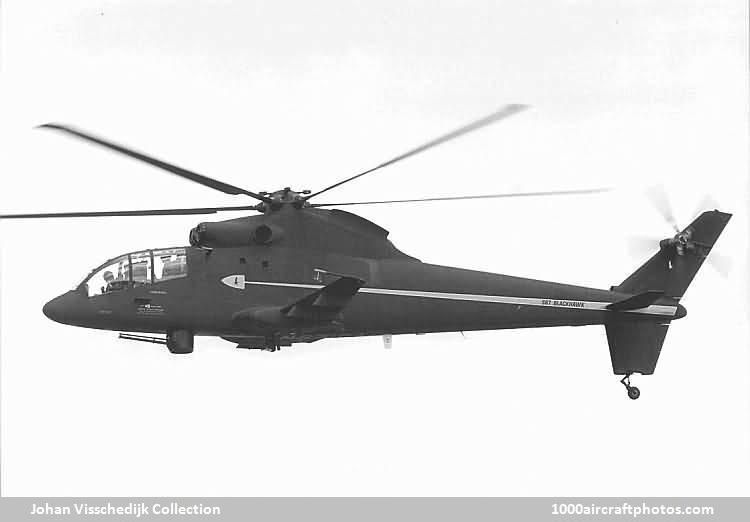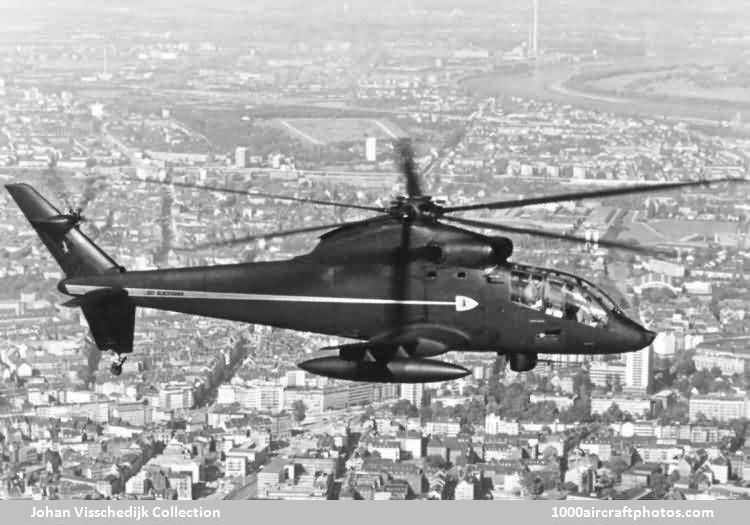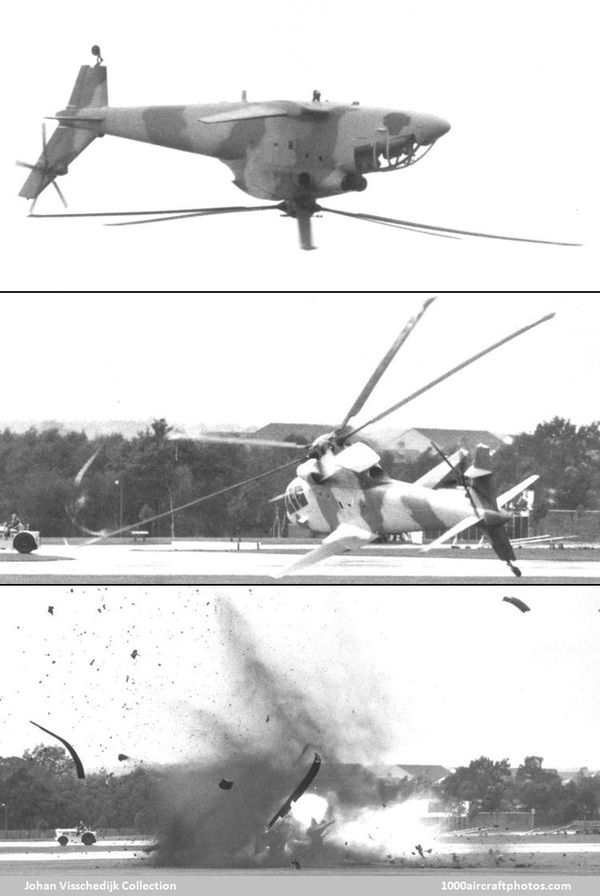08/31/2010. Remarks by
Johan Visschedijk: " On September 22, 1970, Sikorsky announced that a high-speed attack helicopter had completed successfully its initial flight trials. Developed as a private venture, the Blackhawk was a twin-turbine helicopter, utilizing proven components on a low-profile gunship fuselage. A number of new design features were introduced to provide high speed, maneuverability and versatility, some of these emanating from design and flight experience with the S-61F compound helicopter. Design of the S-67 began in August 1969, construction of the prototype starting three months later, while the first flight was made on August 20, 1970.
The S-67 had a vertical fin which extends beneath the fuselage and served also as a mounting for the non-retractable tail wheel. A controllable horizontal stabilizer was mounted at the rear of the long tapered fuselage; when set in a vertical position for hovering flight it reduced vertical drag considerably. In the normal flight position it helped to reduce rotor stresses in maneuvering flight, and allowed the pilot to trim the fuselage independently of the rotor and to achieve better fuselage alignment with the target.
A detachable fixed wing reduced main rotor loading as well as improving maneuverability and, for the first time on a helicopter, speed brakes in both upper and lower wing surfaces could be extended quickly to provide added control. These speed brakes were reported to increase the time on target by 30%, reduce the aircraft's turning radius, permit improved firing accuracy and provide a 38% steeper dive angle. The combined effect of these innovations was to produce a highly maneuverable steeper dive angle.
While the proven dynamic system of the Sikorsky S-61R was used in the S-67, this too underwent development to improve performance. The rotor head was faired to reduce parasitic drag, and the tips of the rotor blades were swept back to delay blade-tip stall at high speeds, improve the lift/drag ratio of the blades and reduce vibratory stresses. Specially designed air intakes also reduced drag at high speed.
The low-profile fuselage design of the Blackhawk not only served to improve speed characteristics, but meant that the gunship offered a more difficult target for an enemy's defensive armament. It presented a frontal flat-plate area of only 17 sq.ft (1.58 sq.m) by comparison with that of the SH-3 Sea King which totaled 32 sq ft (2.97 sq.m).
With a max normal take off weight of around 22,000 lb (9,979 kg), the Blackhawk was in the same general weight class as the S-61 series, and could carry up to 8,000 lb (3,628 kg) of weapons and ammunition. Typical loads included wing-mounted rocket or TOW anti-tank missile pods and under-fuselage and nose turrets housing either 0.3 in (7.62 mm) multi-barrel Miniguns, 0.787 and 1.181 in (20 and 30 mm) cannon or an 1.574 in (40 mm) grenade launcher.
As a troop carrier, with modified cabin, it could transport up to 15 fully-armed troops in the upper section of a two-deck rear compartment, the lower section housed fuel and ammunition. In such a role it would have had a range of up to 220 mls (354 km) at a speed of 165 mph (265 kmh).
When used as a long-range rescue helicopter, with auxiliary fuel tanks mounted on the wings, the S-67 could fly up to 600 mls (966 km) at high speed to recover as many as six persons.
Good payload characteristics meant that the Blackhawk could be used for observation or surveillance duties, equipped with sophisticated electronic devices to detect and record the emplacement and movement of enemy personnel and installations. When carrying troops, or external loads of up to four tons, the Blackhawk would not need the fixed wings, which were easily detachable, since weight-lifting rather than maneuverability would have been the basic requirement.
Construction of the S-67 was simplified by the use of spot-weld bonding of many structures. This involved clamping together the surfaces to be bonded, after spreading uncured adhesive on the mating faces. Spot-welding was then achieved by conventional variable-pressure-type electrodes, followed by curing at low temperature for one hour. This technique was said to be economical, faster and weight-saving, and some 10% of the S-67 airframe area was joined by this process.
On December 14, 1970, the S-67 set a record of 216.844 mph (348,971 kmh) over a 1.864 mls (3 km) course at Windsor Locks, Connecticut, flown by company test pilot Byron Graham. Five days later, company pilot Kurt Cannon flew the S-67 around a 9.32 to 15.53 mls (15 to 25 km) course to establish a record of 220.885 mph (355.485 kmh). Both flights were established as world speed records (under Class E1) by the
FAI.
In February 1972 Sikorsky announced that following completion of 14 months of extensive flight testing the S-67 was to undergo a number of modifications to enhance its day/night attack and multi-mission capability. These included installation of a thermally and acoustically insulated troop compartment providing seats for six men, provision for mounting a removable single-point 8,0001b (3,629 kg) capacity external cargo hook and addition of an integrated rudder to the cambered tail fin to increase yaw control at high speed. In the autumn of 1972 the S-67 made a two-month tour of Europe and the Middle East, covering more than 7,500 mls (12,070 km) in 136 flight hours.
Sikorsky received a $2,1 million two-year contract, awarded by the US Army, for a feasibility study of a ducted tail rotor concept. This involved the design and installation of a ducted variable-pitch fan, replacing the conventional tail rotor, to enhance directional control of the S-67 and reduce vulnerability to damage from contact with other objects. Installation of a new tail unit incorporating the ducted fan was completed in early 1974 and flight testing, which began in the spring of 1974, was designed to determine whether the "fan-in-fin" concept can offer greater maneuverability. Speeds of up to 230 mph (370 kmh) were achieved in a dive.
Subsequently the tail was reverted to its original configuration with the conventional tail rotor, the overall black finish was replaced by a sand camouflage finish, and the aircraft went to the Farnborough International Air Show in the UK.
Having flown a total of 700 hours the Blackhawk was lost in a crash at Farnborough on September 1, 1974, when it failed to complete an aerobatic maneuver, as pictured in these Flight International photos. The co-pilot Stu Craig was killed instantly, the pilot Kurt Cannon died ten days later."


